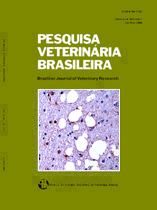 |
|
|
|
Year 2013 - Volume 33, Number 11
|

|
Cluster detection analyses for temporal-spatial characterization of bovine tuberculosis in Bahia, Brazil, 33(11):1313-1318
|
ABSTRACT.- Ávila L.A., Perez A.M., Ferreira Neto S.J., Ferreira F., Telles O.E., Dias A.R., Amaku M. & Gonçalves V.S.P. 2009. [Cluster detection analyses for temporal-spatial characterization of bovine tuberculosis in Bahia, Brazil.] Análise de detecção de cluster na caracterização espaço-temporal da tuberculose bovina no Estado da Bahia. Pesquisa Veterinária Brasileira 33(11):1313-1318. Programa Nacional de Controle e Erradicação da Brucelose e Tuberculose Bovina, Agência Estadual de Defesa Agropecuária da Bahia, Secretaria de Agricultura do Estado da Bahia, Av. Ademar de Barros 967, Salvador, BA 40170-110, Brazil. E-mail: luciana.avila@adab.ba.gov.br
Bovine tuberculosis (BTB) is a disease caused by the infection with Mycobacterium bovis that affects humans and several mammalian species. BTB is important, because it inflicts far-reaching economic losses to infected regions, and due to its impact on public health. Epidemiological surveys were conducted in the State of Bahia between 2008 and 2010 with the objective to estimate the prevalence and to assess the spatial distribution of the disease. The State of Bahia has been stratified into four regions, each of them representing a set of homogeneous epidemiological and demographic characteristics, referred to as Production Circuits. A total of 18,810 more than 2-year-old cattle in 1,305 herds, ranging from 320 to 370 ones per region, and 20 to 40 cattle per herd were randomly selected. A cervical comparative test was applied to each selected animal; reactive cattle and cattle with two consecutive inconclusive tests were considered BTB-positive, whereas non-reactive cattle were considered BTB-negative. Positive herds were classified as those with ≥20 sampled cattle and at least one BTB-positive, as well as those with 40 cattle sampled with ≥2 BTB-positive animals. Latitude and longitude were recorded for each sampled herd with a generic Global Positioning System (GPS). The Cuzick-and-Edwards’ test and the spatial scan statistic were used to assess whether BTB was spatially clustered. Herd-level prevalence, as indicated by the proportion of case-herds, was 1.6% (range 0.3 to 2.9% per region). No significant evidence (P<0.05) of spatial clustering was detected, most likely due to the low disease prevalence in the region. Results here suggest that BTB is low prevalent in the State of Bahia and that under these conditions epidemiological outbreaks found cannot be explained by spatially-structured factors. |
| |
|
|
| |
|
 |